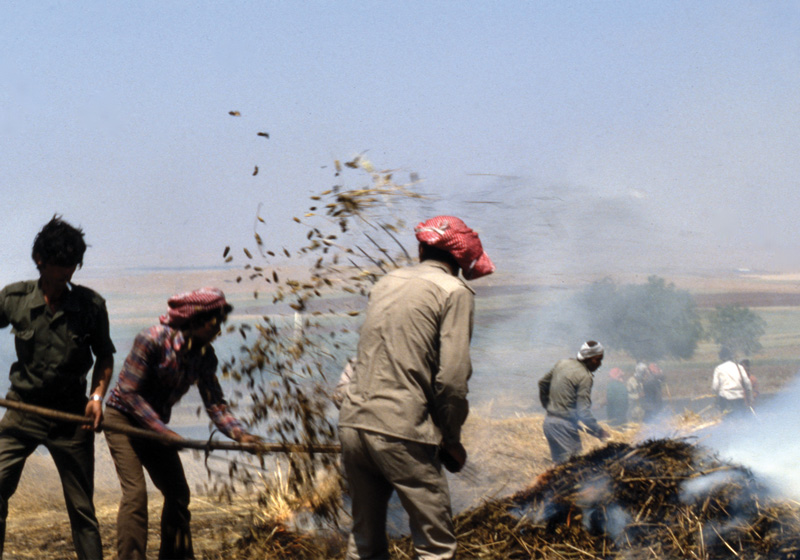Fires of Freekeh
There were few cars and a tractor. Further away from the main road, a strange event was taking place. Before arriving to the spot, you could see a cloud of smoke about the size of a big house, with an occasional figure emerging and disappearing again in the midst of the sweet-smelling smoke.
There were twenty-five or thirty professional freekeh-burners, fully equipped with red kuffyyas, large wooden wheat forks, and synchronized movements as natural as wheat itself. The whole event looked like an ancient ritual, and it was, when the first crop of pre-harvest green wheat is turned into something sacred, an act of initiation, celebrating the eternal cycle of harvests and life.

Freekeh is something from the dawn of time. The idea of quick burning of wheat while still green, conjures credible imaginations of pre-bread practices as old as the domestication of wheat on this land ten thousand years ago. The earliest freekeh seems to have been invented by nature itself, when a late-spring thunderstorm struck a bunch of wild wheat. Nature could have, also, experimented with freekeh during volcanic eruptions. Whatever the means, an early hominid gourmet must have picked up the secret.
The art of freekeh-burning depends on picking the green wheat exactly at the right time. Wheat has to be mature enough to have full-size grains. In fact, one of the secrets of freekeh is that its grains are bigger than dry wheat. At the correct timing, grains are sweet, full of milky liquid, and miraculously fit to resist being totally burned. As the swift fire is distributed by throwing lumps of burning stems into the air, the flame roasts the grain, giving it a luster of brown caramel and marinating its moist core with a pinch of smoke. To spread the fire, and at the same time stop wheat from over-burning, movements of workers with their wooden gear appeared like a theatrical act, a ritual dance, in the middle of a stage in fire and smoke.
The men burning the wheat intrinsically knew all the secrets, they knew the subtlety of this preparation, as a work of a magician, in which grain is turned into the most delicious meal directly on the field, in a shortcut, without kitchens, and without the long process needed to turn wheat into bread.
Holding the hot grains, you would rub them between your palms that move like a tuning mill, separating the half-burned skins of the grains and then blowing them away, freekeh has a delicious smoky-sweet taste, it is chewy and joyfully al-dente. “Farak” is rub in Arabic.
To see the burning of green wheat to produce freekeh needs good timing. These days the traditional outdoor burning practice is becoming more and more difficult to find, especially after the emergence of mechanized freekeh production that turned this ancient practice into a sterile, boring industrial process, producing freekeh without much taste. The most likely location to witness freekeh making would be in the wheatlands to the south and east of Irbid - the landscape around the village of Nuaymeh or Shatana, and if you are lucky, you might spot the freekeh-burning feast on the roadside between Al Husn and Irbid. It seems that in the northern parts of Jordan, Syrian freekeh-burning labor, cross the border for the seasonal job. Now is the beginning of freekeh season. For photography, a normal film, 100 asa, is appropriate. Action shots might be more fun if you pick some moving shapes smeared across the image, the limited focus range (depth of field) can make images more three-dimensional.